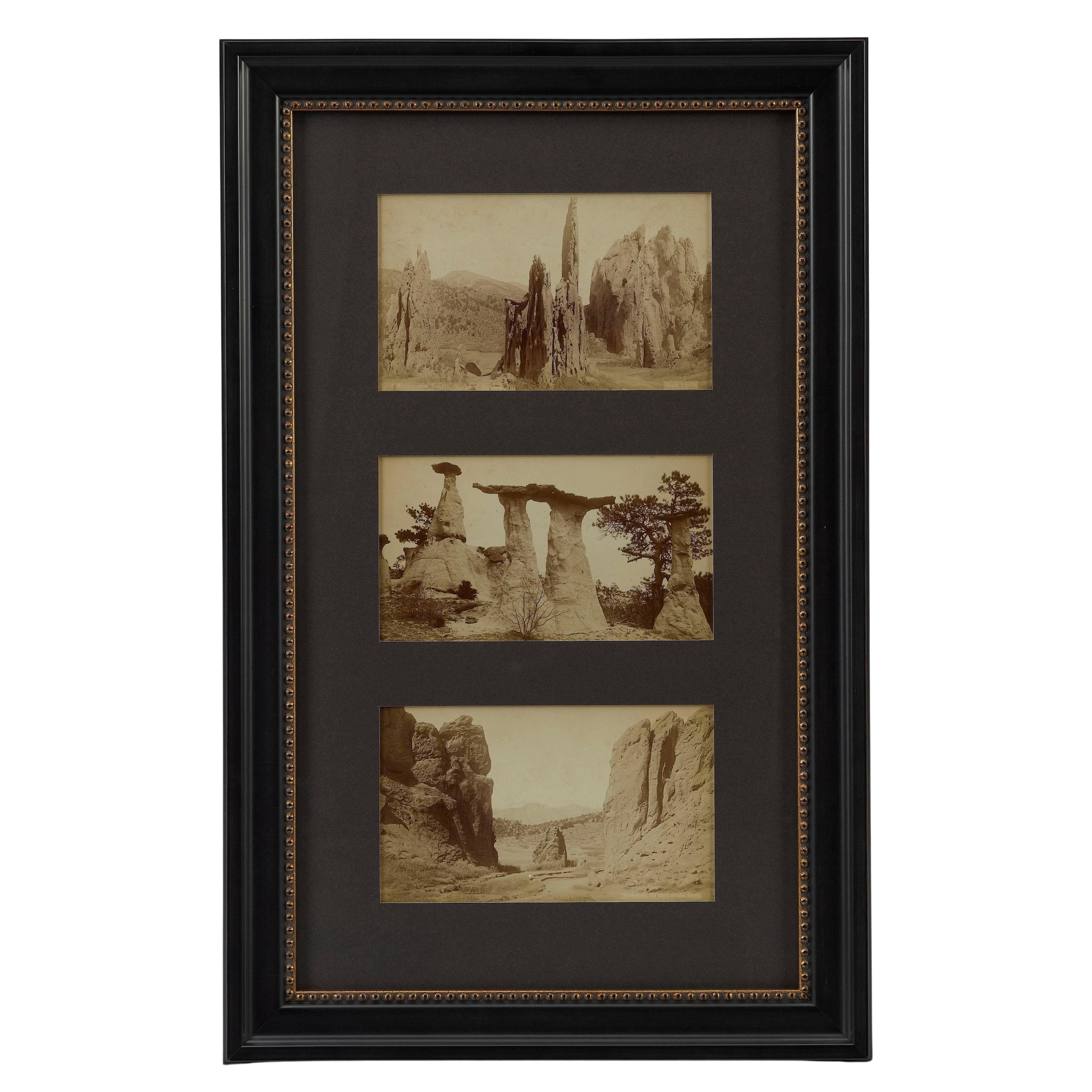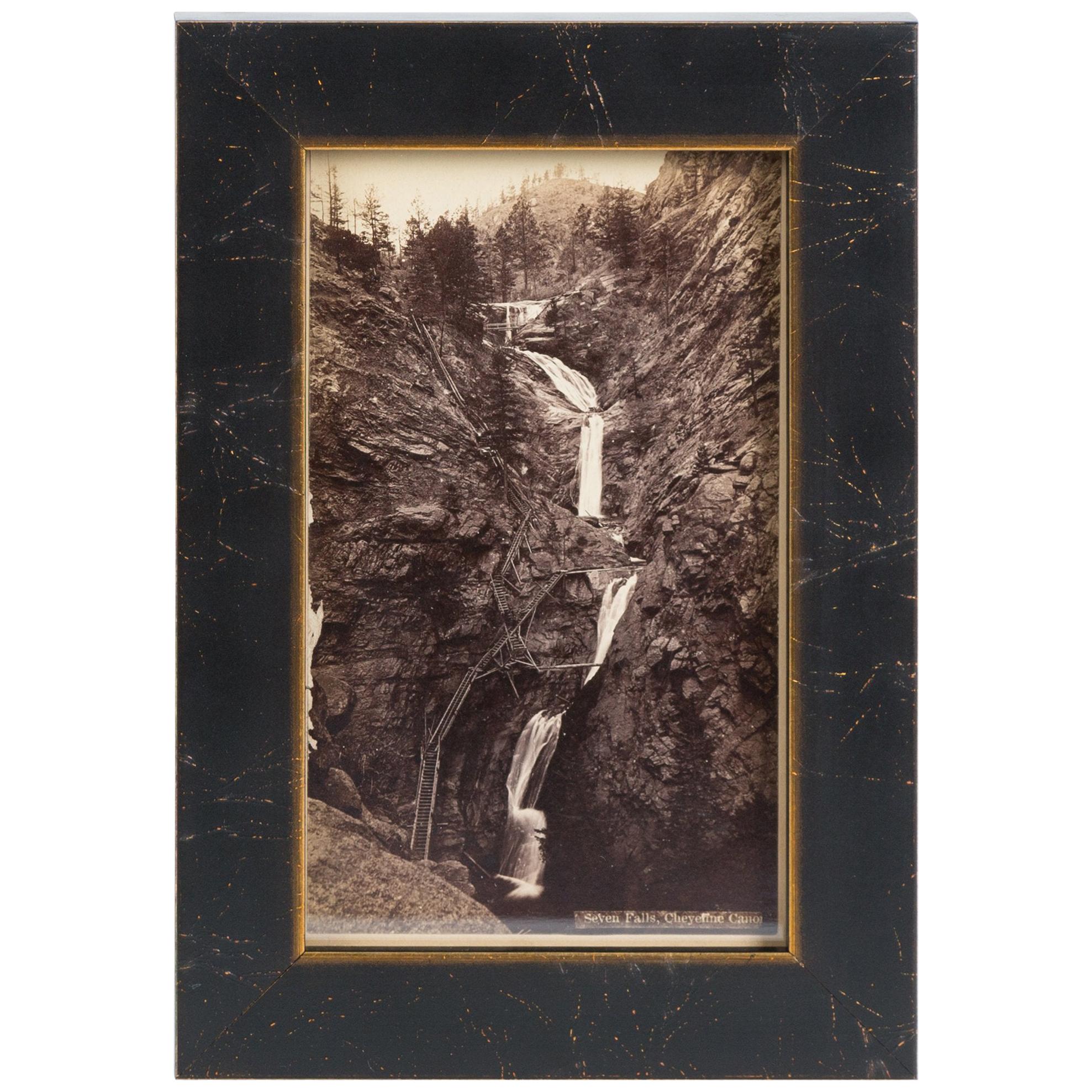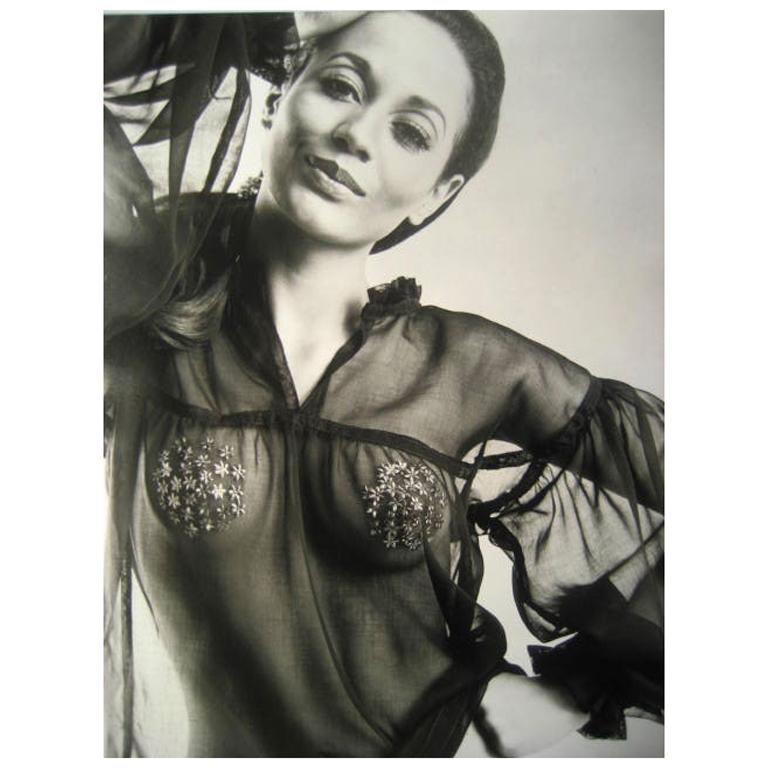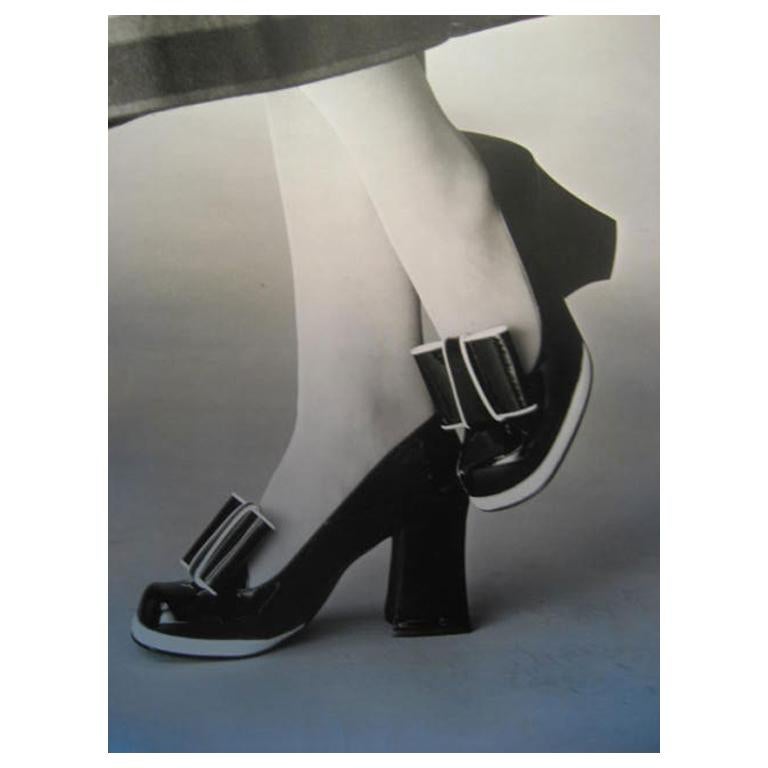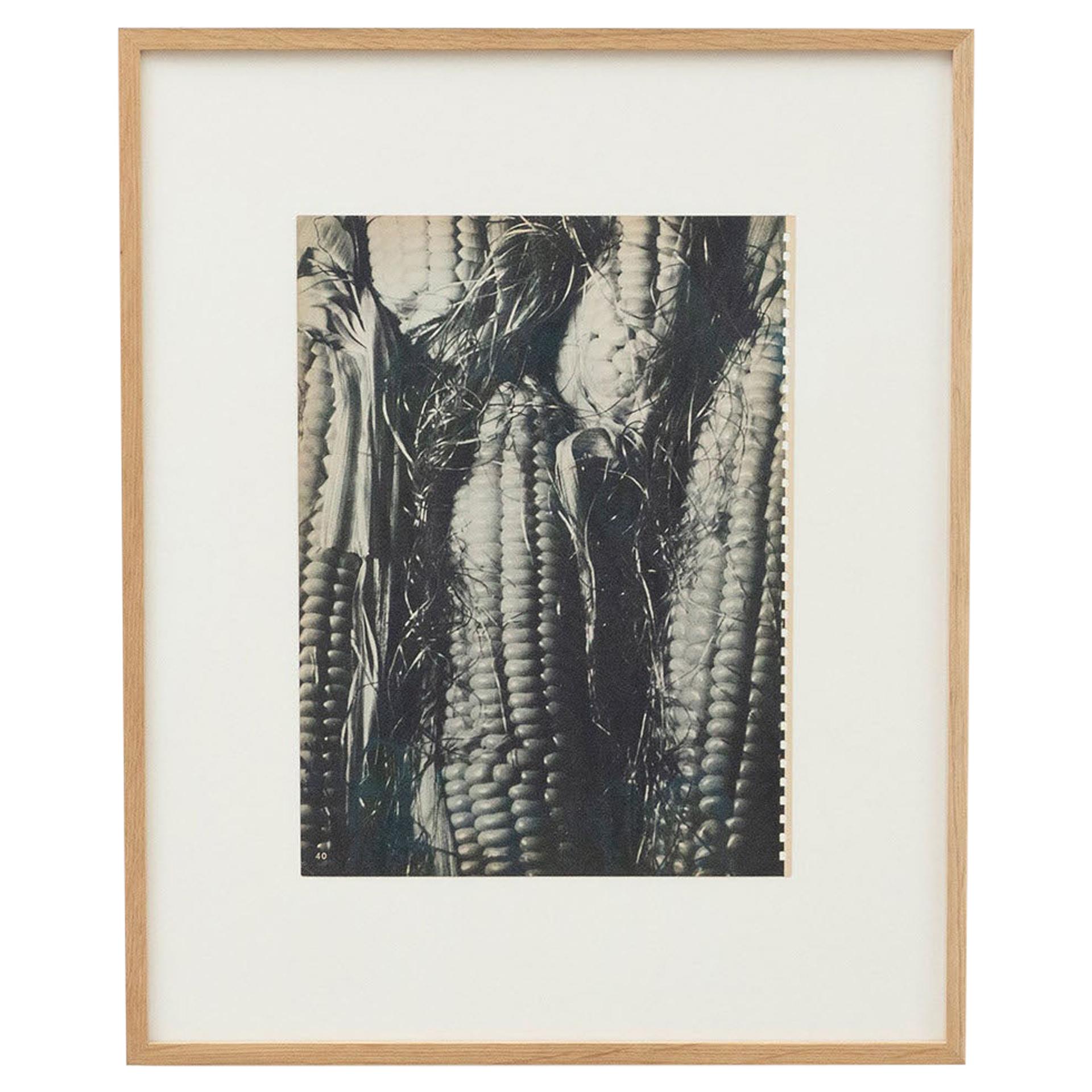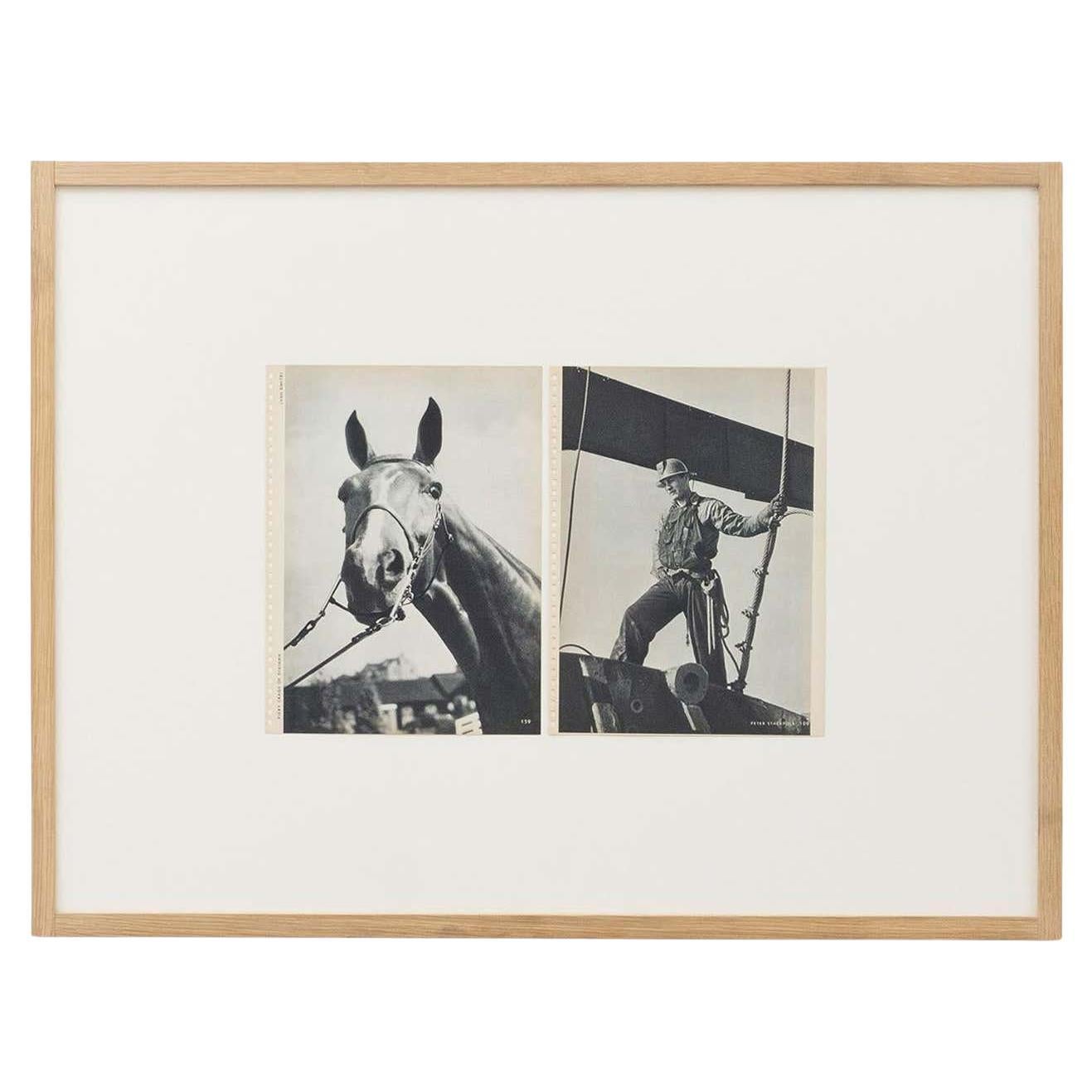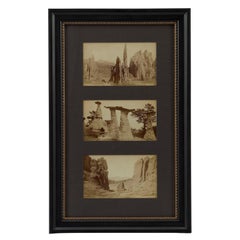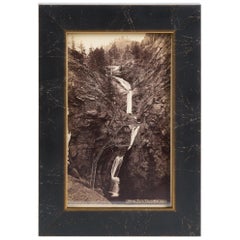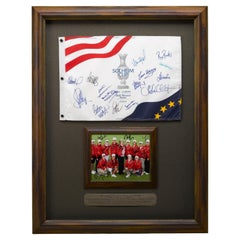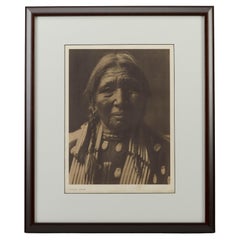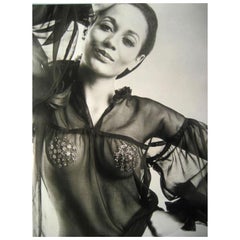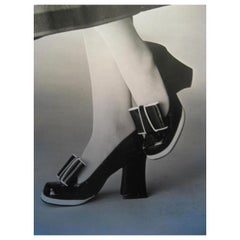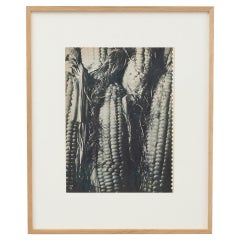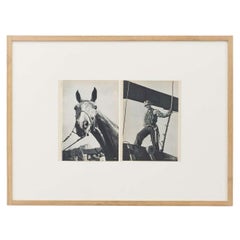Items Similar to Vintage Colorado Springs Postcards by Hook Photo, 1890
Video Loading
Want more images or videos?
Request additional images or videos from the seller
1 of 8
Vintage Colorado Springs Postcards by Hook Photo, 1890
About the Item
Presented is a collage of six vintage cabinet card photographs of Colorado Springs and its surrounding areas, dating to the 1890s. The sepia toned photographs were published by W.E. Hook View, Stationery and Book Company. The photographs capture views of glorious natural vistas for which Colorado Springs is so well known- the Three Graces at the Garden of the Gods, Ute Pass in Manitou Springs, the Narrows at Williams Canyon, Pillars of Hercules, Seven Falls, and Cheyenne Canon.
A style of photograph first introduced in 1863 by Windsor & Bridge in London, the cabinet card is a photographic print mounted on stiff card stock. The Cabinet card got its name from its suitability of display in parlors, especially in cabinets. It was a popular medium for family portraits and landscapes and many cabinet cards were mailed to friends and family living afar or abroad. Cabinet cards reached their peak of popularity in the 1870s through the 1890s. They continued to be made into the 1900s, albeit less frequently, once traditional postcards became popular.
Between 1877 and 1881, photographer William Edward Hook (1833-1908) traveled and captured scenic vistas throughout Montana and Wyoming, from his home base in Missoula. He then moved to the Pikes Peak area of Colorado Springs and set up his photography studio. Early cabinet cards of his are stamped on the verso with his address "W. E. View Stationary and Book Company, 27 South Tejon St., Colorado Springs, Colorado" and advertise both photography supplies and development, give a list of popular photographs, and boast over "2000 Photographic Views of Colorado scenery, Artistically Colored to Choose From".
CONDITION:
Overall, very good condition. Six sepia albumen photographs, each mounted on a stiff card. Some toning to edges. Approximately 8” x 5" each. Framed Dimensions: 22" H x 21 1/2" W x 1 1/4" D.
- Dimensions:Height: 22 in (55.88 cm)Width: 21.5 in (54.61 cm)Depth: 1.25 in (3.18 cm)
- Materials and Techniques:
- Place of Origin:
- Period:
- Date of Manufacture:1890
- Condition:Additions or alterations made to the original: Archival framing by Rio Grande Framing in Colorado Springs, CO, in November of 2022. Wear consistent with age and use. Minor fading.
- Seller Location:Colorado Springs, CO
- Reference Number:Seller: PR465cs1stDibs: LU909733397282
About the Seller
4.9
Platinum Seller
Premium sellers with a 4.7+ rating and 24-hour response times
Established in 2010
1stDibs seller since 2011
453 sales on 1stDibs
Typical response time: 1 hour
- ShippingRetrieving quote...Shipping from: Colorado Springs, CO
- Return Policy
Authenticity Guarantee
In the unlikely event there’s an issue with an item’s authenticity, contact us within 1 year for a full refund. DetailsMoney-Back Guarantee
If your item is not as described, is damaged in transit, or does not arrive, contact us within 7 days for a full refund. Details24-Hour Cancellation
You have a 24-hour grace period in which to reconsider your purchase, with no questions asked.Vetted Professional Sellers
Our world-class sellers must adhere to strict standards for service and quality, maintaining the integrity of our listings.Price-Match Guarantee
If you find that a seller listed the same item for a lower price elsewhere, we’ll match it.Trusted Global Delivery
Our best-in-class carrier network provides specialized shipping options worldwide, including custom delivery.More From This Seller
View AllVintage Garden of the Gods Postcards by Hook Photo, 1890
Located in Colorado Springs, CO
Presented is a collage of three vintage cabinet card photographs of the Garden of the Gods, in Colorado dating to the 1890s. The sepia toned photo...
Category
Antique 1890s American Photography
Materials
Paper
Seven Falls Colorado Springs Antique Photographic Postcard, circa 1880
Located in Colorado Springs, CO
Presented is an antique photographic postcard of Seven Falls, Colorado, from 1880. Postcard production blossomed in the late 1800s and early 1900s, as railroads opened up much of the Western frontier to new and exciting travel opportunities.
Seven Falls is one of Colorado’s most captivating natural wonders. Located at the base of the Front Range, this magnificent series of waterfalls is situated in a 1,250-foot-wall box canyon between the towering Pillars of Hercules and boasts a 181-foot drop of falling water.
Seven Falls was originally part of land given to Nathan Colby in 1872 as part of the Homestead Act of 1862. The Homestead Act granted 160 acres of surveyed land to pioneers in the west, with claimants required to “improve” the plot by building a dwelling and cultivating the land. Mr. Colby promptly sold the track of land to James Hull...
Category
Antique 1880s American Historical Memorabilia
Materials
Paper
Solheim Cup Matches U.S. & European Team Signed Photo & Flag, 2009
Located in Colorado Springs, CO
Presented is an autographed collage celebrating the women golfers of the 2009 Solheim Cup U.S. and European teams. The 11th Solheim Cup Matches were held Au...
Category
Early 2000s American Sports Equipment and Memorabilia
Materials
Fabric, Paper
"Ogalala Woman" by Edward S. Curtis, 1908
By Edward S. Curtis, 1868-1952
Located in Colorado Springs, CO
Presented is a fine photogravure portrait of an Ogalala woman by Edward Curtis. The image is Plate 94 from Supplementary Portfolio 3 of Edward Curtis' epic project The North American Indian. The caption provided by Curtis for this image is “A face so strong that it is almost masculine, showing strikingly how slight may be the difference between the male and female physiognomy in some Primitive people.” The photograph was taken in 1907 and the photogravure was published in 1908 by John Andrew & Son, in Boston.
Edward S. Curtis created one of the most enduring and iconic visual records in the history of the photographic medium. He was an award-winning artist, a consummate craftsman, a visionary, an intrepid entrepreneur, and was highly regarded as a respected ethnographer and publisher.
Curtis began photographing Native Americans in the mid-1890s and selling these images in his successful Downtown Seattle studio. One of his earliest models was Princess Angeline, the aged daughter of chief Sealth, the Suquamish Indian after whom Seattle is named. At the National Photographic Convention of 1899 Curtis was awarded the grand prize for three of his soft-focused, sepia-toned images of Puget Sound Native Americans: Evening on the Sound, The Clam Digger, and The Mussel Gatherer.
Curtis spent the summer of 1900 with George Bird Grinnell observing the Sun Dance at an encampment of Blood, Blackfeet, and Algonquin in Montana. This was a pivotal experience for Curtis, confirming his desire to study and photograph the Native tribes of North America. A trip to visit the Hopi reservation in Arizona a few months later further fueled his enthusiasm. Curtis envisioned a plan to create a massive scholarly and artistic work that would document the tribes west of the Mississippi, their ceremonies, beliefs, daily life, and landscapes.
In 1906, Curtis approached railroad tycoon J.P. Morgan to request financial assistance for his project. Morgan agreed to pay him a total of $75,000, or $15,000 a year for five years. Morgan and Curtis decided that Curtis' masterwork, The North American Indian, would be a set of 20 volumes of ethnographic text illustrated with high quality photoengravings taken from his glass plate negatives. Each of these volumes would be accompanied by a portfolio of large Size images, all sumptuously bound in Moroccan leather. The papers used for printing would also be of the best quality: a Dutch etching stock by Van Gelder, a Japanese vellum, and for the most discerning subscribers, a translucent Japanese tissue paper. To fund publication, Curtis would sell subscriptions at approximately $3,000 per set, with a total of 500 sets to be published.
An ambitious and extensive project, Curtis spent much of his life documenting as many Native tribes as possible. The importance and the urgency of the task was clear to him, as he wrote in the introduction to his first volume of The North American Indians in 1907, "The information that is to be gathered . respecting the mode of life of one of the great races of mankind, must be collected at once or the opportunity will be lost." In 1930, some 24 years after his initial request for funding, the last two volumes, Vol. 19 and Vol. 20, were published and The North American Indian project was finally completed. Curtis took over 40,000 photographs and made over 10,000 wax cylinder...
Category
Antique Early 1900s American Photography
Materials
Paper
"Bear's Teeth - Arikara" by Edward S. Curtis, 1908
By Edward S. Curtis, 1868-1952
Located in Colorado Springs, CO
Presented is a fine photogravure portrait of Bear’s Teeth of the Arikara tribe by Edward Curtis. The image is Plate 154 from Supplementary Portfolio 5 of Edward Curtis' epic project The North American Indian. The caption, written by Curtis, for this image is as follows: “A member of the Night order of the medicine fraternity.” This photogravure was published in 1908 and was printed by John Andrew & Son, in Boston.
Edward S. Curtis created one of the most enduring and iconic visual records in the history of the photographic medium. He was an award-winning artist, a consummate craftsman, a visionary, an intrepid entrepreneur, and was highly regarded as a respected ethnographer and publisher.
Curtis began photographing Native Americans in the mid-1890s and selling these images in his successful downtown Seattle studio. One of his earliest models was Princess Angeline, the aged daughter of chief Sealth, the Suquamish Indian after whom Seattle is named. At the National Photographic Convention of 1899 Curtis was awarded the grand prize for three of his soft-focused, sepia-toned images of Puget Sound Native Americans: Evening on the Sound, The Clam Digger, and The Mussel Gatherer.
Curtis spent the summer of 1900 with George Bird Grinnell observing the Sun Dance at an encampment of Blood, Blackfeet, and Algonquin in Montana. This was a pivotal experience for Curtis, confirming his desire to study and photograph the Native tribes of North America. A trip to visit the Hopi reservation in Arizona a few months later further fueled his enthusiasm. Curtis envisioned a plan to create a massive scholarly and artistic work that would document the tribes west of the Mississippi, their ceremonies, beliefs, daily life, and landscapes.
In 1906, Curtis approached railroad tycoon J.P. Morgan to request financial assistance for his project. Morgan agreed to pay him a total of $75,000, or $15,000 a year for five years. Morgan and Curtis decided that Curtis' masterwork, The North American Indian, would be a set of 20 volumes of ethnographic text illustrated with high quality photoengravings taken from his glass plate negatives. Each of these volumes would be accompanied by a portfolio of large size images, all sumptuously bound in Moroccan leather. The papers used for printing would also be of the best quality: a Dutch etching stock by Van Gelder, a Japanese vellum, and for the most discerning subscribers, a translucent Japanese tissue paper. To fund publication, Curtis would sell subscriptions at approximately $3,000 per set, with a total of 500 sets to be published.
An ambitious and extensive project, Curtis spent much of his life documenting as many Native tribes as possible. The importance and the urgency of the task was clear to him, as he wrote in the introduction to his first volume of The North American Indians in 1907, "The information that is to be gathered ... respecting the mode of life of one of the great races of mankind, must be collected at once or the opportunity will be lost." In 1930, some 24 years after his initial request for funding, the last two volumes, Vol. 19 and Vol. 20, were published and The North American Indian project was finally completed. Curtis took over 40,000 photographs and made over 10,000 wax...
Category
Antique Early 1900s American Photography
Materials
Paper
Charlie Duke Signed Photograph of Apollo 16 Moonwalk
Located in Colorado Springs, CO
Presented is an Apollo 16 mission photograph, signed and inscribed by Apollo 16 moonwalker Charlie Duke. The photograph shows Duke collecting lunar samples n...
Category
Vintage 1970s American Modern Photography
Materials
Paper
You May Also Like
A Vintage Fashion Photo by John Adriaan
By John Adriaan
Located in St.Petersburg, FL
A great, vintage, fashion photo by J. Adriaan. Matted-frame not included.
Category
Vintage 1960s English Photography
A Vintage Fashion Photo by J.Adriaan
By John Adriaan
Located in St.Petersburg, FL
A classic, vintage photo of shoes, ca' 1969, by J.Adriaan.
Category
Vintage 1960s English Photography
Vintage Photo Gravure, circa 1940
Located in Barcelona, Barcelona
Vintage photo gravure, circa 1940.
Wood frame with passepartout and high quality museum's glass.
In original condition, with minor wear consistent with age and use, preserving a ...
Category
Vintage 1940s French Mid-Century Modern Photography
Materials
Glass, Wood, Paper
$1,233 Sale Price
25% Off
and Peter Stackpole Vintage Photo
Located in Barcelona, Barcelona
Vintage photo gravure by the photographers Fiery Crags and Peter Stackpole, circa 1940.
Wood frame with passe-partout and high quality museum's glass....
Category
Vintage 1940s French Mid-Century Modern Photography
Materials
Glass, Wood, Paper
$2,427 Sale Price
25% Off
Tintype Displaying Buffalo Bill Poster Circa 1890s (Photo from Tintype Included)
Located in Incline Village, NV
This is a Buffalo Bill item that would have appeal for collectors of both western and Buffalo Bill meomorabelia. It is a tintype, circa 1890s (the Buffalo Bill shows started in 1883)...
Category
Antique 19th Century American Victorian Photography
Materials
Tin
Set of 12 Custom Finely Framed Scottish Postcards, Vintage Catherine Reiss Inc
Located in Manhasset, NY
Set of 12 custom framed Scottish postcards, vintage Catherine Reiss Inc. Six framed group of cards with two in each frame.
Category
Late 20th Century Modern Political and Patriotic Memorabilia
Materials
Glass, Wood
